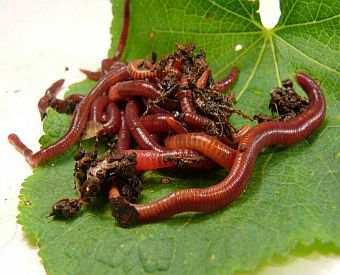Red Wiggler Express Fundamentals Explained
Red Wiggler Express Fundamentals Explained
Blog Article
The Definitive Guide for Red Wiggler Express
Table of ContentsHow Red Wiggler Express can Save You Time, Stress, and Money.Top Guidelines Of Red Wiggler ExpressThe 9-Minute Rule for Red Wiggler ExpressMore About Red Wiggler ExpressFacts About Red Wiggler Express RevealedRed Wiggler Express - Truths
If you do not feed them they will certainly go trying to find food. Like all worms red worms breathe oxygen via their skin. In order to breathe they require a wet, however not saturated bed linen product. A damp atmosphere also assists in the failure of raw material in their bedding product by microbial life kinds.
During mating worms slide along each other until their clitellum are straightened. During the breeding session, which lasts for regarding 3 hours, the worms secrete mucus rings around themselves.
See This Report on Red Wiggler Express
However before handing over all the required reproductive materials are scooped up right into the ring. When the mucus ring goes down off the worm the end seals up, causing it to taper at one end, creating the familiar lemon form of the cocoon (Worm Farms United States). Over the next 20 days the cocoon dims and solidifies
Some worm farmers in fact withhold food and water to imitate dry spell conditions and bump up cocoon manufacturing. We do not recommend this for the home composter as it has the potential to eliminate off way too many of your best worms. Since you recognize all concerning the red worm it's time to go out and locate an excellent vendor and obtain a pound or more and start your very own worm farm.

The smart Trick of Red Wiggler Express That Nobody is Discussing
The digestive system is easy, starting at the mouth where the worm starts to consume its food prior to passing it on to the throat. The vocal cords is a muscular section which imitates a pump to pull food into the mouth prior to pumping it out into the esophagus. The esophagus is narrow and thin-walled and functions as the "waiting area" for the gizzard.
Keep in mind: This need for grinding is why grit is advised in a worm bin. The worm features no native grinding ability so the worm depends on consumed grit to help grind its food in the gizzard. The belly is where the initial chemical failure of food happens with the aid of a protein-busting enzyme.
The intestine develops the lengthiest part of the worm and is where the bulk of food digestion takes location using enymatic processes. The spreadings eventually travel through the anus at the end of the worm as pills coated with a biologically-rich mucous. (You're not eating I hope.) Red wigglers will certainly intertwine around one an additional, exchanging sperm through their skin.
An Unbiased View of Red Wiggler Express
Within 42 days, these infant worms will reach sexual maturation as confirmed by the development of the clitellum. A fully grown red wiggler can be expected to live in between one to three years. The magnificent red wiggler may sometimes be used as a lure worm for smaller sized fish or as a healthy protein resource for poultries and reptiles.

And as pointed out above, they are one of the most usual composting worm in the world. Why? Well there's probably not simply one reason. Rather, a mix of expense, hardiness, and comfort in a wide variety of temperature levels makes it the most appropriate composting worm for most brand-new vermicomposters. Red wigglers and their cocoons can make it through in a variety of problems.
This is a common practice amongst worm shippers that do not want to risk having the worms rest in a warm or chilly storage facility over the weekend break. Worm cultivators are not saving worms in a circumstance where they are ready to deliver. The worms need to be harvested from their environment first, so farmers will frequently set a Friday or Saturday target date in order to harvest in time for a Monday delivery.
See This Report on Red Wiggler Express
To conserve on delivery price, you may want to see if there are any type of neighboring "Mother and Pop" shops via a Google search.
I call these the "Huge 3" elements of worm bin upkeep. As stated previously, red wigglers have a large temperature tolerance.
A lot of worm bin proprietors run their worm bins way also wet. And a properly-maintained worm container must not be creating leachate.
For finest results, you want to strive about 60-70% dampness level. The easiest examination for this is to squeeze a handful as difficult as you can. At the perfect wetness levels which is just under 70% that handful should barely produce one drop of fluid. pH in a worm bin is rather simple to preserve.
See This Report about Red Wiggler Express
The European Nightcrawler, the larger relative of the red wiggler, is equally as voracious and additionally creates an excellent lure worm - Worm Farms United States. It prefers a little bit of a cooler atmosphere than the red wiggler. The African Nightcrawler is an extremely big composting worm and makes a stunning, granular cast
(https://www.whofish.org/events/Hickory/NC/Red_Wiggler_Express/5604228.aspx)The Indian Blue is ravenous, however likewise likes a warmer climate and it additionally exhibits a tendency to escape the bin. The red wiggler is a hardy worm and isn't as choosy regarding its climate. I such as to call it the Ford Taurus of vermicomposting worms; you will not boast to your hardcore composting pals that you possess them, yet they will serve you well.
Surefire alive 1/2 lb of hand arranged Red Wigglers/Compost with worms (+500 worms) in different stages of life from cocoons to grow worms in their natural environment/bedding. Hand arranged worms minimized the disruption of the worms hence guaranteeing online shipment. Red wiggler worms do not like vibrations or light.
Report this page